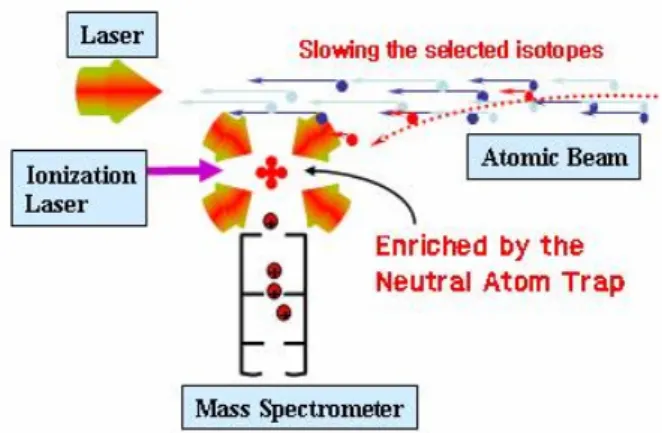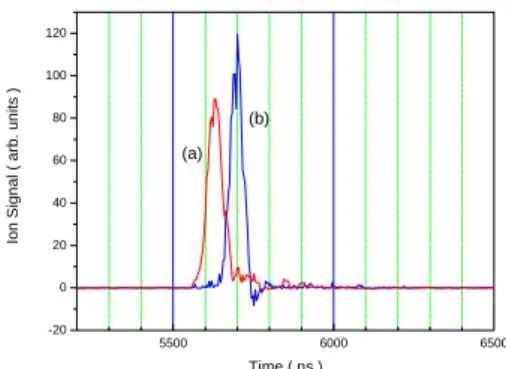Demonstration of the Atom Trap and Mass Spectrometry for the Detection of Sr Rare
Isotopes
a
Kwang-Hoon Ko, aDo-Young Jeong, aGwon Lim, aTak-Soo Kim, aDukhyeon. Kim, aHyung Ki Cha, bYou-Kyoung Lim
a Laboratory for Quantum Optics, Korea Atomic Energy Research Institute, Yusong, Daejeon, Korea,P.O.Box 105 khko@kaeri.re.kr
b Department of Physics, Chungbuk University, 12 Gaesin-dong, Cheongju, Chungbuk, Korea
1. Introduction
Trace isotope analysis has become an essential tool in basic research, environmental science, archaeological dating and geology [1]. Especially, the detection of the trace radio isotope 90Sr, which is a fission product, has been of interest because of the nuclear industry and an environmental assessment.
Recently, the neutral atom trap method has been developed for analyzing ultra trace isotopes, such as 81
Kr, 85Kr and 41Ca [1-3]. This method is not only free of contamination from different isotopes or isobar, but it also has a higher isotope selectivity than that of the other laser based methods. Moreover, other enrichment processes for handling the neutral atoms such as an atomic beam collimation and a Zeeman slowing technique are able to be applied to increase an enrichment factor for the interested isotope. Recently, we reported on selective characteristics of the magneto optical trap on the strontium atoms [4]. The higher isotope selective spectrum than other laser based methods was obtained in this report. But, the quantitative result could not be obtained from the fluorescence spectrum, because of the complexity of the trap simulation. We’ve demonstrated a new analytic method, called an ATMS (atom trap mass spectrometry), which increases the selectivity and can be applied to have a quantitative result of the selectivity of MOT.
In this paper, the magneto optical trap followed by the time of flight mass spectrometer has been demonstrated. The trapped atoms are photo-ionized and accelerated in the electric field. The characteristics have been investigated to have knowledge of the isotope selective process of them.
2. Experimental setup
The atomic structure of the strontium is shown in fig. 1. The strong 460.7 nm cycling transition (5s2 1S0 – 5s5p 1P1) is used for slowing down and trapping the strontium atoms. There is a 5s4d 1D2 leak (decay rate of 3.9 X 103 s-1) which strongly governs the performance of the Sr MOT. Atoms that decay from the 1D2 state to the long-lived 3P2 state are lost from the trap. The leakage shortens the trap lifetime of the strontium MOT.
Figure 1. Strontium level diagram showing relevant laser wavelengths.
The trap laser beam is able to populate 5s5p 1P1 (21698 cm-1), 5s4d 1D2 (20149.7 cm-1), and 3Pj (J = 0,1) state (14504.531 cm-1 , 14898.563 cm-1) and the atoms on these levels can be ionized over the ionization level (I.P = 46018 cm-1) by the two photon process with a strong pulse laser.
The atomic beam was extracted in the atomizer operating at 600 oC and collimated by the two slits. Zeeman slowing technique was used to longitudinally slow down the atomic beam to the capture velocity. The two anti-Helmholtz coils created the magnetic field gradient of 50 G/cm in the trap center. The single mode laser beam was split into two parts, one was used for the slowing beam and the other for the trapping beam after being shifted +110 MHz to the blue side by an acousto optic phase modulator. The laser power of about 100 mW was applied for the trapping beam, the slowing beam and the frequency stabilization setup.
Figure 2. Experimental setup for trapping and slowing strontium atoms.
Transactions of the Korean Nuclear Society Autumn Meeting Busan, Korea, October 27-28, 2005
The frequency doubled Nd:YAG laser was provided for the ionization of the trapped neutral atoms. The laser beam intensity was controlled by a polarizer and a half-lambda plate, and the laser beam was incident on the trap chamber after passing through the focusing lens with the focal length of about 500 mm.
The two acceleration plates were biased to about 3 kV and 1 kV and the other was grounded. The ions were passed through the deflection region and detected by a multi-channel plate. The flight distance from the ion source to the detector was about 40 cm.
3. Experimental Result
The size of the plate and distance between the acceleration plates and their sizes was limited because of the trap chamber size. Therefore, a numerical simulation should be achieved to conform to the separate isotope signals. We used the commercial program (SIMION ver. 7.0) to obtain knowledge on the ion trajectory and rough isotope selectivity. In addition, a 2-dimensional simulation which includes the electron collision and the coulomb repulsion has been perform for observing the mass signals depending on the electrode geometry and the biased voltages.
Figure 3 shows the fluorescence spectrum when the frequency of the trap beam was scanned. The frequency was tuned to the fluorescence peaks which are marked A and B in the figure. At first, the laser frequency was tuned to the position B to optimize the ion signal by adjusting the acceleration voltage and the deflection voltages.
The mass spectrum was obtained when the laser frequency was tuned to maximize the fluorescence from the trapped atoms. Figure 4 shows the two mass spectra after ionizing the trapped atoms; signal (a) is for the trapped 88Sr atoms and signal (b) the trapped 86Sr atoms. The flight time and the width of the mass spectrum were observed at about 5.5 us and 30 ns, respectively. The flight time depended on the acceleration voltage and the width that was related to the mass resolution depended on both the acceleration voltages and the trap position. -300 -200 -100 0 100 2 3 4 5 6 B A 86 Sr 87 Sr 88 Sr Fl uo res c e nc e I n te ns it y (a rb . un it s) Frequency ( MHz )
Figure 3. Fluorescence from the trapped atoms as a function of laser frequency. The fluorescence peaks are positioned at the red side of the corresponding resonancelines. The x-axis shows the relative frequency from the 88Sr peak.
5500 6000 6500 -20 0 20 40 60 80 100 120 (b) (a) Ion S ign al ( arb. un its ) Time ( ns )
Figure 4. Mass spectrum of the trapped strontium atoms. The ion signal was obtained when the laser frequency was tuned to maximize the fluorescence of trapped 86Sr atoms (a), and 88Sr atoms (b). The mass signal for trapped 86Sr atoms was magnified by five. The bias voltages were 3 kV and 1 kV. The x-axis shows the flight time of each isotope.
4. Conclusion
Strontium ATMS has been demonstrated for the first time. Even though the system cannot resolve all the strontium isotopes, it is sufficient to confirm an increase of the isotope selectivity by attaching the mass spectrometer. However, a better mass resolution is needed to investigate the isotope characteristics of the trap and how much the isotope selectivity increases in the ATMS. For this study, a re-design of the acceleration plates will be needed in the future.
REFERENCES
[1] X. Du, R. Purtschert, K. Bailey, B.E.Lehmann, R.Lorenzo, Z.T. Lu, P. Mueller, T. P. O’Connor, N.C. Sturchio, L. Young, “A New Method of Measuring 81Kr and 85Kr Abundances in Environmental Samples”, Geophysical Research Letters, Vol. 30, pp. 2068 (2003).
[2] I.D.Moore, K.Bailey, J.Greene, Z.T.Lu, P.Mueller, T.P.O’Connor, Ch. Geppert, K.Wendt, L. Young, “Counting individual 41Ca atoms with a Magneto-Optical Trap”, Physical Review Letters, Vol. 92, pp. 153002 (2004).
[3] C. Y. Chen, Y. M. Li, K. Bailey, T. P. O’Connor, L. Young, Z.-T. Lu, “Ultrasensitive Isotope Trace Analyses with a Magneto-Optical Trap”, Science, Vol. 286, pp. 1139-1141 (1999).
[4] K. H. Ko, D. Y. Jeong, G. Lim, T. S. Kim, Y. H. Cha, H. K. Cha, Y. K. Lim, “Isotope Selection Characteristics of MOT for the Detection of the Sr Rare Isotopes”, Korean Nuclear Society (2005)

